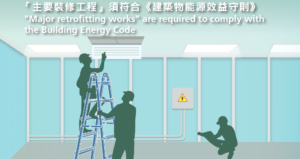
About 90% of total electricity consumption in Hong Kong is contributed by buildings. Through enhancement of building energy efficiency, greenhouse gas emissions can be effectively reduced. In October 1998, the Electrical and Mechanical Services Department has launched the voluntary Hong Kong Energy Efficiency Registration Scheme for Buildings to promote the application of the Building Energy Code. To further promote building energy efficiency, the Government enacted the Buildings Energy Efficiency Ordinance (the Ordinance) which has come into full operation since 21 September 2012 (Note: Registration under the voluntary Scheme is not regarded as having complied with the Ordinance).
The 3 key requirements of the Ordinance
- The developers or building owners of newly constructed buildings should ensure that the 4 key types of building services installation therein, namely, air-conditioning installation, lighting installation, electrical installation as well as lift and escalator installation, comply with the design standards of the Building Energy Code (BEC).
- The responsible persons (i.e. owners, tenants or occupiers etc.) in buildings should ensure that the 4 key types of building services installation therein comply with the design standards of the BEC when “ major retrofitting works ” are carried out.
- The owners of commercial buildings (including the commercial portions of composite buildings, e.g. shopping malls under residential storeys) should carry out energy audit for the 4 key types of central building services installation therein in accordance with the Energy Audit Code (EAC) every 10 years. (Note: If energy audit has already been carried out in advance before 21 September 2012, please refer to the transitional arrangement).
Programme target and scope
The BEC component of the BEEO covers most public and private commercial buildings in Hong Kong. In addition to offices, this includes, for example, hotels, government, municipality, educational and transport related buildings, in addition to commercial portions shared with industrial and residential buildings. The EAC component focuses on the four central service installations of commercial buildings and the commercial portion of composite buildings.
The BEEO covers both new and existing buildings. New buildings are those having obtained consent for the commencement of building works for superstructure construction from the Building Authority after 21 September 2012 (i.e. after commencement of the BEEO). Existing buildings are those whose permits were obtained prior to this.
The major retrofitting works covered by the BEC are those involving addition or replacement of a services installation covering a total floor area of 500 m2 or more. The BEEO also targets the addition or replacement of a main component of a services installation. This may include addition or replacement of a complete electrical circuit at a rating of 400A or above; a unitary air-conditioner or air-conditioning chiller of a cooling or heating rating at or exceeding 350 kW; or the motor drive and mechanical drive of a lift, an escalator or passenger conveyor.
Sources:
Electrical and Mechanical Services Department
C40 (report attached)